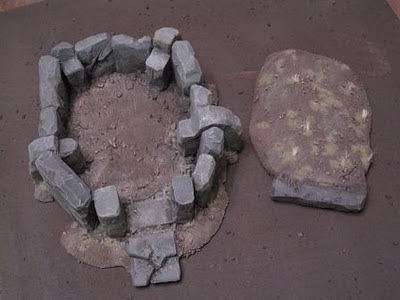Painting. Aside from actually building the terrain it's probably the most important step. But that doesn't mean it has to be super hard, some basic techniques are all you really need for a good paint job.
First up is the primer coat. Just like painting a miniature the primer coat gives you a base to build off, but with terrain it also has some structural benefit as well. For the primer I start with latex paint. I get mine at a home improvement store. I get a gallon of matte, latex, indoor paint and have the color matched to a dark brown acrylic paint I have. GW scorched brown or charadon granite are both good colors. A gallon of paint will last you a long time as long as you keep it sealed up.
My primer coat is a mix of the latex paint and glue. This helps to stick all of the texturing material down. I mix it about 2 parts latex paint, 2 parts water, and 1 part glue. Again like the sealant coat you want it about the consistency of melted ice cream.
Two things to keep in mind when applying the primer: wait overnight for the texturing material to dry on and once you have the primer on don't go over the textured area again. Make sure it is covered thoroughly the first time and don't fuss with it. Otherwise, you'll find the water in the primer weakening the glue and the texturing material coming off. Instead just paint the primer on heavily and try to get it in all of the nooks and crannies. Let it dry and then your ready for the real painting to begin.
 |
| With the primer on the ruins are starting to take shape. |
For painting terrain I use acrylic craft paints and large brushes. Using other paints tends to get expensive and brushes for working on miniatures would just take too long. They don't have to be the best quality since painting the terrain tends to beat them up. You can make do with just about anything but one brush your going to want is a stiff bristled round brush for dry brushing and stippling.
 |
| My small ruin after the primer coat has dried. |
For the base coat I just painted everything a dark grey. Then I went back in and painted some blocks a darker grey and others a lighter grey. This helps to give the natural variation that you see in stonework.
 |
| Three tone base coat |
Then I stippled on a dark brown on the lower courses of blocks, the flagstones, and more lightly on the top edges of the stones. To do stippling just take a stiff brush and load it with paint then wipe off most of the paint on a paper towel like you are dry brushing. But instead of dragging the brush across the edges instead stab straight at the ruins. It makes a semi random splotch. Just keep on going till your satisfied with the look. I stipple on a coat of dark mossy green as well keeping it more evenly spread across piece.
Next is a dark wash. I like to use a mix of black, grey, brown and green to give a dark brownish grey. Make sure it is thin enough that it will run into the recesses. Paint this into all of the cracks and crevices and also across all of the gravel. Now is a good time to hit all of those hard to reach spots that you happened to miss in previous steps. Also, anyplace where you might have knocked any of the texturing material off while painting. This step can get pretty messy as the wash runs through all of the cracks in the ruins and out the bottom. You don't have to hit all of the flat areas but don't worry if you do. Now wait for it to dry completely.
 |
| After the wash is dried |
Now we move on to dry brushing. I worked from a dark grey up through a lighter grey mixing in browns and greens to the grey occasionally. For the darker colors I try to hit the stones from all sides, but as I get to the lighter colors I'm mostly working from the top down like sunlight hitting it. You want it to look natural and not overly highlighted.
Then I painted some dark brown into the areas where there would be dirt and stippled on some more greens. After that dried the whole thing got a light dry brushing of tan to tie everything together.
 |
| Painting complete |
Next up: Finishing Touches


















































